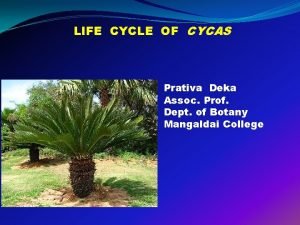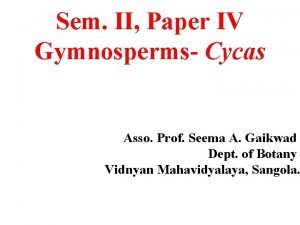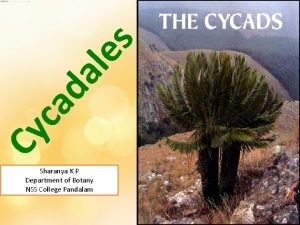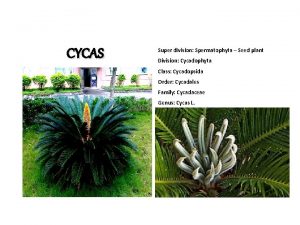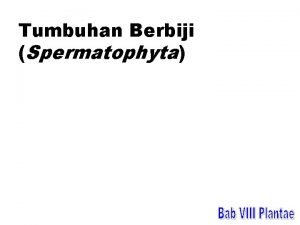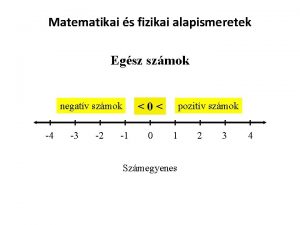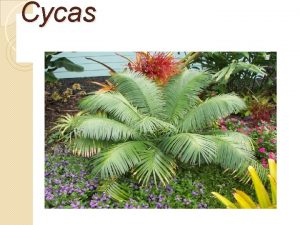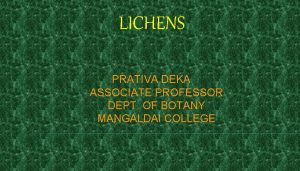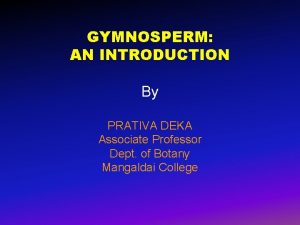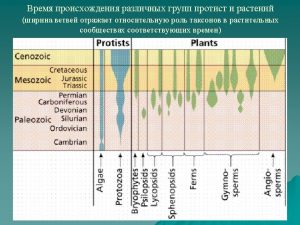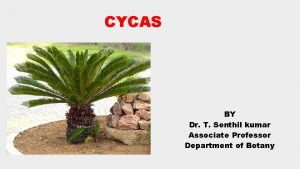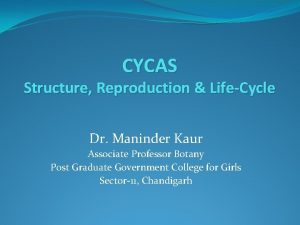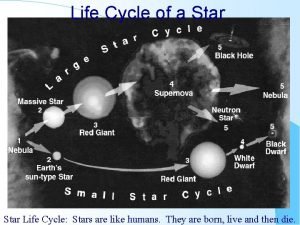LIFE CYCLE OF CYCAS Prativa Deka Assoc Prof




















- Slides: 20

LIFE CYCLE OF CYCAS Prativa Deka Assoc. Prof. Dept. of Botany Mangaldai College

Systematic Position Class-Cycadopsida Order-Cycadales Family-Cycadaceae Genus-Cycas

Distribution of Indian species Out of 20 spp 5 spp grow in India 1. 2. 3. 4. Cycas circinalis L. -South India C. beddomei Dyer-Andhra Pradesh C. pectinata Griff-Eastern India C. rumphii Miq. -Andaman and Nicobar Islands 5. C. revoluta Thunb. -Japanese sp widely cultivated as ornamental plant in India

General morphology Stem - Stout, generally unbranched bearing a crown of leaves at the top, bears adventitious buds at the base Leaves - two kinds: small brown scale leaves and large pinnately compound foliage leaves. Root - Tap root system. Coralloid roots or corallorhiza formed from some apo-geotropic roots which are inhabited by Anabaena cycadacearum a blue green alga

Anatomy of stem The stem anatomy of Cycas is simple and shows some primitive features. It shows the following tissues: 1. Epidermis 2. Cortex 3. Endodermis, Pericycle and Vascular Cylinder 4. Medullary rays 5. Pith

Anatomy of Leaf A transverse section of leaflet shows the following tissues; 1. Cuticle 2. Epidermis 3. Hypodermis 4. Mesophyll Tissue 5. Transfusion Tissue 6. Vascular Bundle 7. Primaary transfusion Tissue

l Sexual Reproduction

All living Cycas are dioecious. The microsporophylls are aggregated into large compact strobili or cones. But the megasporophylls are losely arranged. They do not form a true cone. l

Structure of male cone �Male cone is a long, compact, spindle-shaped structure. It has a central woody axis. �Several microsporophylls are spirally arranged around the axis. �Each microsporophyll is woody flattened wedgedshaped structure. �It bears hundred of microsporangia on its lower surface in clusters of three to six.


Structure of female strobilus �There is no true and compact female cone in Cycas. �A crown of megasporophylls spirally arised in acropetal succession at the apex of the stem. �The megasporophylls are large and divided into an upper broad leafy portion and a lower stalk like portion. �The leafy portion is more or less pinnately lobed, tapering to a point. �Ovules are borne laterally on the lower stalk-like portion which are vary in number from two to ten.


Structure of ovule

Gametophytic generation

Development of Male Gametophyte �These developmental changes can be grouped under two main heads: �A. Developmental changes before pollination �Development of Microspore �Cell division in the Microspore �Pollination �B. Developmental changes after pollination �Formation of stalk and body cell �Development of the pollen tube �Formation of the male gametes

Fig. Development of male gametophyte

Development of Female Gametophyte The development of female gametophyte of Cycas is monosporic. These process can be divided into following heads: 1. Formation of megaspore 2. Development of female prothallus 3. Development of archegonia

Fertilization q After the formation of archegonia the pollen tube burst and discharge its contents into the archegonial chamber. q The sperms swim within the archegonial chamber. q One of them swims to an archegonium, enters it and makes its way down the egg. q Then the sperm fuses with the female nucleus.

Conclusion q The Cycads are obviously primitive plants. q They bear many resemblance with the group Cycadofilicales or cycad ferns. q Cycadofilicales were abundant in the coal period and are now extinct. q The living Cycads resemble these plants in many respects and hence called the “living fossils. ”

Thanks
 Cycas life cycle
Cycas life cycle Common lisp assoc
Common lisp assoc Angus gestation calculator
Angus gestation calculator Cycas revoluta
Cycas revoluta Colleroid
Colleroid Male cycad cone
Male cycad cone Cycas
Cycas Strobilus jantan melinjo
Strobilus jantan melinjo Deka vitaminok
Deka vitaminok Prefixum fogalma
Prefixum fogalma Deka+
Deka+ A századrészt jelentő si-prefixum
A századrészt jelentő si-prefixum 10 deka polnische in a wachauer
10 deka polnische in a wachauer Kilo hecto deka
Kilo hecto deka Deka dancil
Deka dancil Methods of plant disease management
Methods of plant disease management Centi milli deci
Centi milli deci Acronym for metric system king henry
Acronym for metric system king henry Kilo hecto deka
Kilo hecto deka Deka number
Deka number Khdudcm extended
Khdudcm extended
